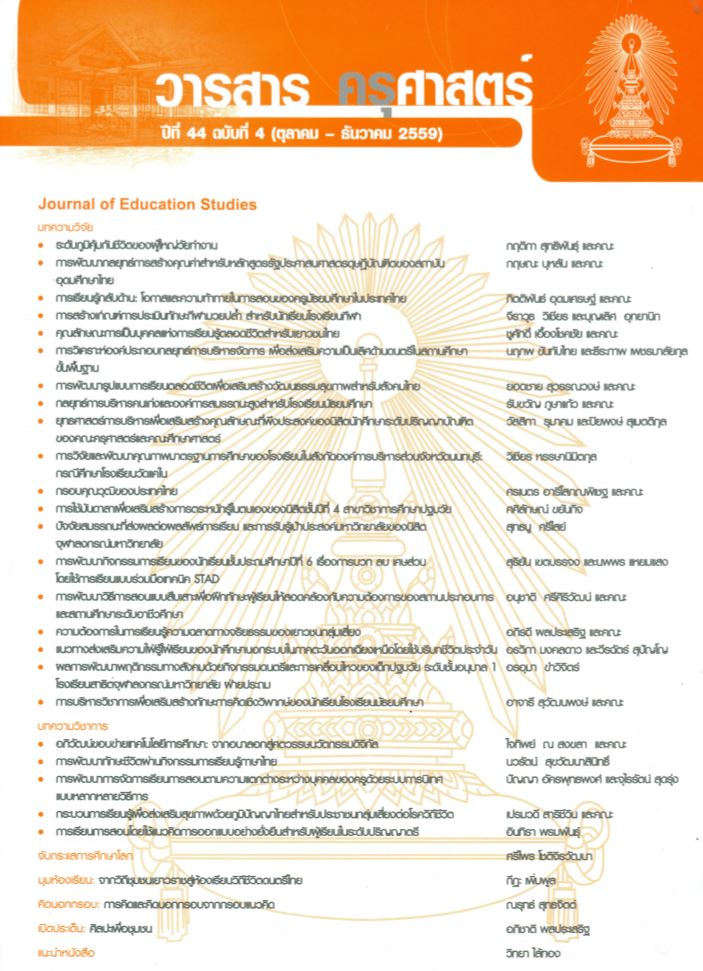กระบวนการเรียนรู้เพื่อส่งเสริมสุขภาพด้วยภูมิปัญญาไทยสำหรับประชาชนกลุ่มเสี่ยงต่อโรควิถีชีวิต
Keywords:
กระบวนการเรียนรู้เพื่อส่งเสริมสุขภาพด้วยภูมิปัญญาไทย, ประชาชนกลุ่มเสี่ยงต่อโรควิถีชีวิต, a learning process to promote health base on Thai wisdom, at-risk people of lifestyle diseases.Abstract
การวิจัยแบบเชิงคุณภาพครั้งนี้ เพื่อศึกษากระบวนการเรียนรู้เพื่อส่งเสริมสุขภาพด้วยภูมิปัญญาไทยสำหรับประชาชนกลุ่มเสี่ยงต่อโรควิถีชีวิต
ผลการศึกษาครั้งนี้ พบว่า กระบวนการเรียนรู้เพื่อส่งเสริมสุขภาพด้วยภูมิปัญญาไทยสำหรับประชาชนกลุ่มเสี่ยงต่อโรควิถีชีวิต ประกอบด้วย 2 หลักการ ได้แก่ 1) แนวทางวิถีสุขภาพพอเพียง (พอเพียง พอประมาณ และพอดี) 2) การมีส่วนร่วมของประชาชนและหน่วยงานท้องถิ่น และ 8 องค์ประกอบ ได้แก่ 1) ผลที่เกิดจากปัญหาที่รู้สึกไม่พึงพอใจในชีวิต 2) ความรู้เรื่องการส่งเสริมสุขภาพด้วยภูมิปัญญาไทย 3) แรงบันดาลใจของผู้เรียน 4) บุคคลต้นแบบ 5) วิถีชีวิตของชุมชน 6) สื่อการสอน 7) แหล่งเรียนรู้ชุมชน 8) บรรยากาศการเรียนรู้ และประกอบด้วยขั้นตอนการเรียนรู้ 14 ขั้นตอน ได้แก่ 1) การรับรู้ความรู้สึกไม่พึงพอใจต่อปัญหาที่กำลังเผชิญอยู่ 2) การตรวจสอบตนเองถึงสาเหตุของปัญหาอย่างมีเหตุผล 3) การพูดคุยแลกเปลี่ยนความคิดเห็นกับผู้อื่น 4) การปรับเปลี่ยนมุมมองใหม่เพื่อปรับเปลี่ยนพฤติกรรม 5) การสร้างภาพจินตนาการบทบาทใหม่ 6) การตั้งเป้าหมายในการปฏิบัติตามบทบาทใหม่ที่คิดไว้ 7) การเรียนรู้จากการกระทำของต้นแบบ 8) การทดลองปฏิบัติบทบาทใหม่ 9) การสร้างแรงบันดาลใจในการเปลี่ยนแปลงตนเอง 10) การฝึกปฏิบัติตามบทบาทใหม่ 11) การดัดแปลงวิธีปฏิบัติใหม่ให้เข้ากับวิถีชีวิต 12) การกำหนดมาตรการควบคุมกำกับตนเอง 13) การประเมินผลการปฏิบัติตามบทบาทใหม่ 14) การพัฒนาให้เป็นนิสัยใหม่
This qualitative research was to study a learning process to promote health based on traditional Thai Wisdom for those at-risk people of lifestyle diseases.
The results of this study showed that a traditional Thai wisdom-based health promotion learning process for at-risk persons for developing lifestyle diseases is composed of 2 principles: 1) a sufficient way of promoting healthy lifestyles (sufficiency, moderation and fitness); and 2) the participation of citizens and local authorities. The components of this learning process are 1) the effect of disorienting dilemmas, 2) having knowledge to promote health based on traditional Thai wisdom, 3) learner’s inspiration, 4) role models, 5) local community lifestyle, 6) access to instructional media, 7) local learning resources, and 8) establishing an organizational learning climate. This model also consists of 14 learning steps: 1) perceiving of disorienting dilemma, 2) self-examination to identify causes of problems, 3) sharing opinions through dialogue, 4) modifying a new viewpoint to change behavior, 5) imagining a new role, 6) creating a target according to this new role , 7) learning from role models, 8) trying out new roles, 9) creating an inspiration to change behavior, 10) practicing a new role, 11) integrating new practices to lifestyles, 12) determining self-control determination, 13) evaluating the new role, and 14) developing new habits.




